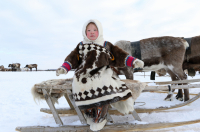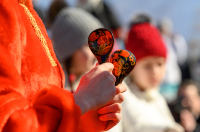In ancient times, the Finno-Ugric peoples were united and populated a large area near the Ural Mountains, but by the first century BC, they had spread across the continent and separated into several branches. The Baltic-Finnic branch occupied regions by the Baltic Sea and developed further to form the separate but related Finnish, Estonian, Karelian, Livian, Votian, Vepsian, and Izhorian peoples.
The last three are included on the list of small native peoples of the Russian Federation. Nowadays, their population is indeed really small, and even among them not everyone is fluent in their native languages. The smallest ethnic group of these three are the Votians (less than a hundred representatives), followed by the Izhorians (around 1,300 representatives), and the Vepsians (around 6,000 representatives).
Listening to beautiful songs in such rare tongues is one of the ways to learn a little more about them.
Izhorians
These are truly singing people – thousands of songs in Izhorian were collected over the past two centuries and some of them were used when compiling Kalevala, the greatest Finno-Ugric epic.
By the way, there’s a great Izhorian Ethnographic Museum in the village of Ruchii, Leningrad Oblast, where you can check out their national costumes and crafts and learn more about the Izhorians.
Vepsians
The Vepsian language and, correspondingly, culture, greatly suffered under the Soviet policy of assimilation, but, thankfully, significant attempts have been made to preserve Vepsian: for instance, this language is taught at Petrozavodsk State University, there’s a Museum of Veps Ethnography, and there are artists who perform in Vepsian, such as the band VarastA. I was lucky enough to hear them live at a festival dedicated to another small Finno-Ugric ethnic group – Seto, and loved their music.
Votians
Elias Lönnrot, a prominent collector of Finno-Ugric folklore who put together Kalevala, also researched Votian culture: for example, he recorded 29 wedding songs in Votian after talking to a Votian woman. And that’s just one topic and one person! Also, this language has no official script, which makes songs in Votic all the more precious.
Small and fragile languages such as Izhorian, Votian, and Vepsian, without a doubt, deserve to be preserved, as they contribute to the diverse cultural landscape of our region.
Check out our other stories on indigenous peoples of Russia and Finno-Ugric locations in St. Petersburg.




